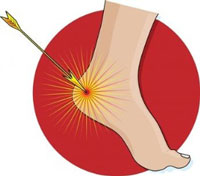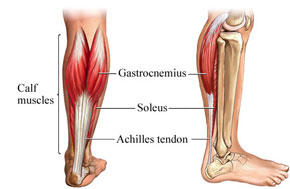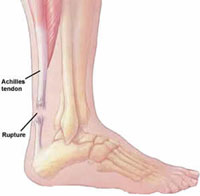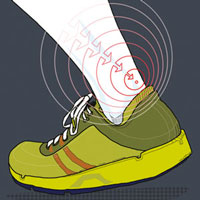Achilles Tendon Rupture (Part One)

The Achilles tendon is in the back part of the heel. The Achilles tendon is one of the strongest tendons in our body and it serves to perform the lifting onto the toes or to perform the push during walking it can be torn from sudden, immediate forces in the foot or ankle.
If the Achilles tendon is torn, you will not be able to rise onto your toes and will walk as if you have a flat foot. It is important to diagnose and treat this injury as soon as possible, to help and encourage healing. Treatment includes placing a brace or a plaster cast for a few weeks, and possibly surgery.



What is an Achilles tendon rupture?
The Achilles tendon is an important part of the foot. It is located behind and above the heel. It connects the heel bone to the calf muscles. Its function is to assist in bending the ankle downwards (this movement is called plantar flexion by doctors).
If the Achilles tendon is torn, this is called an Achilles tendon rupture. The tear can be partial or complete. With a partial tear, it means the tendon is partially torn but still connected to the calf muscles. With a complete tear, it means the tendon is completely torn so the connection is lost between the calf muscles and the bones of the ankle.
What causes an Achilles tendon rupture?
Just like any muscle or tendon in the body, the Achilles tendon can be torn if a high force or stress is exerted on it.
- This can happen with activities that involve a strong push off with the foot - for example, in soccer, running, basketball, diving, and tennis. The sudden push off movement uses a strong contraction of the calf muscles which can stress the Achilles tendon too much.
- The Achilles tendon can also be damaged from injuries like falling, if the foot suddenly is forced from a high position - this movement strains the tendon.
- Another injury could be possible from a deep cut in the back part of the ankle, which could go all the way to the tendon.
- Sometimes the Achilles tendon is weak, making it more prone to rupture. Factors that contribute to the weakening of the Achilles tendon are:
- Treatment with corticosteroids (such as prednisolone) - mainly if it is used as a long-term treatment more than a short course.
- The injection of corticosteroids near the Achilles tendon.
- Certain rare medical conditions, such as Cushing's syndrome, where the body produces too much of its own corticosteroid hormones.
- Getting older.
- Tendonitis (inflammation) of the Achilles tendon.
- Other medical conditions which may make the tendon more prone to rupture. For example: rheumatoid arthritis, gout, and systemic lupus erythematosus (SLE).
- Certain antibiotics may slightly increase the risk of having an Achilles tendon rupture. These are the quinolone antibiotics such as ciprofloxacin and ofloxacin. The risk of having an Achilles tendon rupture with these antibiotics is actually very low, and mostly applies if you are also taking corticosteroid medications or are over or around the age of 60.

Bravo: A very special explanation which made me understand how to deal with Achilles tendon damage, thank you for the work done with rigor and dedication
Sent by Ervis hasibra, më 27 October 2016 në 10:42